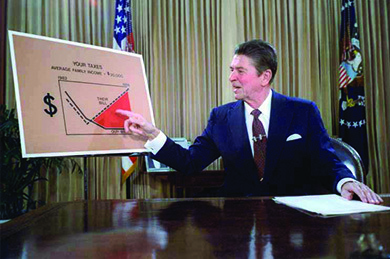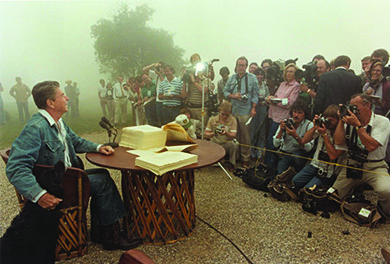| << Chapter < Page | Chapter >> Page > |
Many politicians, including Republicans, were wary of Reagan’s economic program; even his eventual vice president, George H. W. Bush, had referred to it as “voodoo economics” when competing with him for the Republican presidential nomination. When Reagan proposed a 30 percent cut in taxes to be phased in over his first term in office, Congress balked. Opponents argued that the tax cuts would benefit the rich and not the poor, who needed help the most. In response, Reagan presented his plan directly to the people ( [link] ).

Reagan was an articulate spokesman for his political perspectives and was able to garner support for his policies. Often called “The Great Communicator,” he was noted for his ability, honed through years as an actor and spokesperson, to convey a mixture of folksy wisdom, empathy, and concern while taking humorous digs at his opponents. Indeed, listening to Reagan speak often felt like hearing a favorite uncle recall stories about the “good old days” before big government, expensive social programs, and greedy politicians destroyed the country ( [link] ). Americans found this rhetorical style extremely compelling. Public support for the plan, combined with a surge in the president’s popularity after he survived an assassination attempt in March 1981, swayed Congress, including many Democrats. On July 29, 1981, Congress passed the Economic Recovery Tax Act, which phased in a 25 percent overall reduction in taxes over a period of three years.

On March 30, 1981, just months into the Reagan presidency, John Hinckley, Jr. attempted to assassinate the president as he left a speaking engagement at the Washington Hilton Hotel. Hinckley wounded Reagan and three others in the attempt. Here, National Security Adviser Richard V. Allen recalls what happened the day President Reagan was shot:
By 2:52 PM I arrived at the White House and went to [Chief of Staff James] Baker’s office . . . and we placed a call to Vice President George H. W. Bush. . . .
[W]e sent a message with the few facts we knew: the bullets had been fired and press secretary Jim Brady had been hit, as had a Secret Service agent and a DC policeman. At first, the President was thought to be unscathed.
Jerry Parr, the Secret Service Detail Chief, shoved the President into the limousine, codenamed “Stagecoach,” and slammed the doors shut. The driver sped off. Headed back to the safety of the White House, Parr noticed that the red blood at the President’s mouth was frothy, indicating an internal injury, and suddenly switched the route to the hospital. . . . Parr saved the President’s life. He had lost a serious quantity of blood internally and reached [the emergency room] just in time. . . .
Though the President never lost his sense of humor throughout, and had actually walked into the hospital under his own power before his knees buckled, his condition became grave.
Why do you think Allen mentions the president’s sense of humor and his ability to walk into the hospital on his own? Why might the assassination attempt have helped Reagan achieve some of his political goals, such as getting his tax cuts through Congress?

Notification Switch
Would you like to follow the 'U.s. history' conversation and receive update notifications?